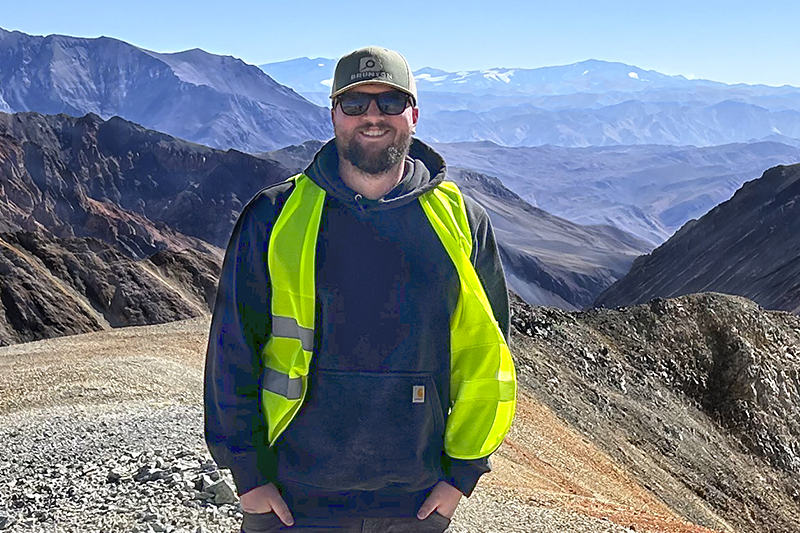


Preserving permafrost
Photos courtesy of Mike Powers February 06, 2025
UD doctoral student Mike Powers heads to Argentina and Chile to study permafrost in the Andes Mountains
High in the Andes Mountains of Argentina and Chile, mining companies are scouring the landscape to look for copper, gold, lithium and cobalt deposits, among other lucrative ores. Most of these metals will be used in sustainable infrastructure like electric vehicles and updating the electric grids worldwide.
At the same time, both countries have robust legislation in place that protects the glacial and periglacial ice, which includes permafrost, also known as frozen ground. These ice deposits are usually found in the same locations where the companies want to mine.
That’s where University of Delaware doctoral student Mike Powers comes in.
Studying glacial geomorphology in the lab group of Michael O’Neal, professor in the Department of Earth Sciences, Powers is trying to identify and quantify the location and amount of permafrost in the Argentinian and Chilean Andes regions. Identifying these areas will serve two purposes: It will delineate the permafrost rich areas and designate them for protection, while enabling miners in the area to sustainably extract ore and avoid those locations when looking for precious metals.
“We’re trying to figure out how much permafrost is in the Andes as a whole, which nobody knows because it’s really hard to see,” Powers said. “There are some surface expressions of it in the form of rock glaciers or other landforms but we’re trying to use different methods to establish the actual extent of permafrost. This will help us establish how much water is locked up in these mountain reservoirs, how we can protect it and how we can enable it to be designated for protection so mining companies can avoid it whenever they start extracting ore.”

The study has produced one of the longest running continuous datasets on ground temperature in the Andes Mountains, which can help identify long-term climate trends and the impact of a warming climate on these high-altitude water reservoirs.
In return for travel to and lodging at the field sites, Powers and members of O’Neal’s lab submit an annual report to the mining companies in the area and to regulators in Argentina.
In March, Powers will travel to Chile and Argentina for the third time in his UD career to study permafrost at four different field sites spread across four latitudes in the Andes Mountains. He relishes the opportunity to conduct hands-on research in the field, as it brings him back to his roots.
Having grown up in central Pennsylvania, where remnants of early glaciation from the Pleistocene era dot and scar the landscape, Powers became interested in glaciated landscapes at an early age.
“There’s a whole glacial history in my hometown that I’ve been curious about and was curious about during my undergraduate work,” Powers said. “I’ve always been interested in high mountain environments, I’ve always been interested in ice, and Mike O’Neal had the perfect project for me to sink my teeth into.”
Powers said his work is at the confluence of sustainability, environmental resources and economic interests. In this part of the world, the glaciated ice can serve as a source of freshwater for the neighboring communities.

Both the Argentine and the Chilean governments recognize permafrost as a strategic freshwater reserve that, in times of drought or decreased snowpack, can supplement the deficit in water availability. This has led them to develop what’s known as the “Law of the Glaciers” designating permafrost and ice-rich landforms for protection.
“The lowland communities in these areas rely on having access to freshwater because it’s an incredibly arid environment,” Powers said. “It’s incredibly dry and so understanding where the water comes from for these communities is going to be crucial going into the future.”
To help understand this, Powers deploys several research methods at the field sites.
The first is to use a giant array of ground temperature sensors — tiny pendants that run on a watch battery — that are buried in certain spots across the Andes and record the temperature every 30 minutes for a full year.
From that data, they can extract the average ground temperatures for a whole area.
Then they’ll use widely available spatial parameters such as slope, aspect, elevation and how much incoming solar radiation the site is getting.
“We input the spatial parameters associated with each of those sensors and do a lot of complex statistics,” Powers said. “We end up getting an equation that we can apply to a remote sensing image, and it will give us a model of where we expect permafrost to be.”
Once Powers gets back from the field, he will conduct his lab research at UD and use the research for his doctoral dissertation.
“My dissertation will not only look at what elevations you get permafrost but, as you move from north to south, how does that distribution of permafrost change and what is the climate variability in these sites,” Powers said. “We’re fortunate that we have all these sites to work with and that we’re able to be there in person, to confirm all the remote sensing and modeling that we’re doing on the back end. I’m grateful that we’re in a really unique position.”

Contact Us
Have a UDaily story idea?
Contact us at ocm@udel.edu
Members of the press
Contact us at 302-831-NEWS or visit the Media Relations website

